September 7, 2007
Air Date: September 7, 2007
FULL SHOW
SEGMENTS
Capturing Carbon
/ Jeff YoungView the page for this story
Will new technology allow us to keep coal power from warming the planet with its greenhouse gas emissions? Living on Earth's Jeff Young visits two very different coal-powered plants to feel the burn. (07:30)
Dioxane on the Defensive
/ Ashley AhearnView the page for this story
A recent study finds levels of dioxane, a chemical that causes cancer in mice and rats, in several name brand soaps and shampoos for kids. Dioxane is banned from cosmetics in the European Union but the U.S. federal government has not set limits for dioxane in consumer products. Living on Earth’s Ashley Ahearn reports. (05:00)
A Movement Leader Speaks
View the page for this story
Host Steve Curwood talks with Nobel Peace Prize winner Wangari Maathai about the legacy of colonialism in Africa and her continued efforts to restore and preserve the world’s forests. Maathai recently released a memoir called “Unbowed.” (11:47)
A Wriggly Business
/ Ian GrayView the page for this story
Maggie Pipkins is a self-employed octogenarian in an unusual line of work. Her business? Growing and selling garden worms. Producer Ian Gray has our portrait. (05:50)
Coal Country Crooner
View the page for this story
Host Steve Curwood speaks with singer-songwriter, Kathy Mattea, about her album "Coal.” Mattea plays some songs and talks about growing up in West Virginia coal country, her relationship with the 'black gold', and how mining and burning coal is affecting the environment and the people in her native state. (17:00)
This week's EarthEar selection
listen /
download
Birdlife in the Florida marshlands.
Show Credits and Funders
Show Transcript
HOST: Steve Curwood
GUEST: Wangari Maathai, Kathy mattea
REPORTER: Jeff Young, Ashley Ahearn, Ian Gray
[THEME]
CURWOOD: From Public Radio International - this is Living on Earth.
[THEME]
CURWOOD: I’m Steve Curwood. Coal is a cheap and plentiful source of energy, but it's taking its toll on the environment. Some scientists say if the U.S. doesn't push for new clean coal technology, we'll be like trains on the track headed for collision.
SOCOLOW: Train number one is the rush to coal power in the U.S.; train number two is the urgency of dealing with climate change. The switch is carbon dioxide capture and sequestration.
CURWOOD: Also, Nobel Peace Prize winner Wangaari Matthai speaks about growing up in the countryside of Kenya, and the damage done by Britain's rule of Africa.
MATTHAI: We need to decolonize the minds of people who have been colonized. Until you decolonize those minds it's very, very difficult for the colonized to liberate themselves from the burden of self-doubt.
CURWOOD: Wangaari Matthai--unbowed….. this week on Living on Earth. Stick around!
ANNOUNCER: Support for Living on Earth comes from the National Science Foundation and Stonyfield Farm.
[THEME RETURN]
Capturing Carbon
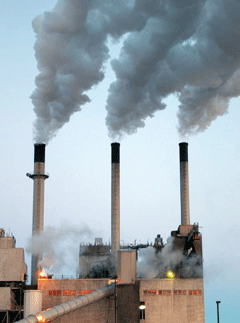
(Photo: Phillip J. Redman, U.S. Geological Survey)
CURWOOD: From the Jennifer and Ted Stanley Studios in Somerville, Massachusetts - this is an encore edition of Living on Earth. I’m Steve Curwood.
Some call it a “coal rush.” Despite growing concerns about clean air and climate change, electric utility companies are pushing for a new fleet of coal-fired power plants in the U.S. Coal is a plentiful domestic source of energy, but all those new power plants could bring a spike in carbon dioxide pollution—a chief culprit in global warming. So scientists are looking for new ways to use this old fuel. One promising approach is called “carbon capture and sequestration.” It would take the CO2 out of power plant emissions and store it deep in the earth. Living on Earth’s Jeff Young looks at how coal might be made more climate friendly. The story is part of our occasional series, “Generating controversy: the changing climate of coal.”
YOUNG: Walking into the Dominion power station at Mount Storm, West Virginia, feels like entering the belly of the beast.
WOOD: Alright put your ear plugs in.
[ROAR OF MACHINERY]
YOUNG: Massive grimy machines feed 15 thousand tons of coal a day to giant boilers. Plant manager Bill Wood shouts above the roar of pure, raw power.
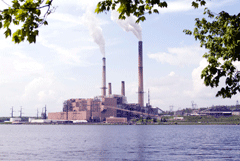
Dominion's Mt. Storm Power Station (Courtesy of Dominion)
YOUNG: Pulverized coal burners like this one dominate the power industry today. This old workhorse powers almost a million homes and has done so for 40 years.
[PASSING THROUGH DOOR PEOPLE GREETING]
YOUNG: In the control room we take out the earplugs and Wood points to a throbbing yellow glow on a monitor screen.
WOOD: When you’re talking about the boilers. We’ve actually got furnace cameras showing the fireball inside the boilers.
YOUNG: Wow, look at that. Man it’s like looking at the sun or something!
WOOD: It’s pretty intense. That fireball at it’s hottest point is probably in the neighborhood of 2,700 degrees Fahrenheit
YOUNG: You’re kind of looking straight into the heart of what your whole industry’s all about, right there.
WOOD: That’s right. We generate steam.
YOUNG: They also generate a lot of carbon dioxide, the main greenhouse gas. A power plant this size can pump out more than six million tons of CO2 a year. There are ways to teach old dogs like Mount Storm the new trick of fetching CO2. One method binds up carbon in the exhaust with ammonia. Another sends pure oxygen into the boiler. Both would likely be very costly, raising the price of electricity as much as 50 percent. Climate scientists say building a whole new fleet of these old style power plants without any carbon capture technology could be a climate disaster. Princeton University professor Robert Socolow compares it to trains on a collision course.
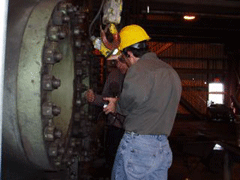
(Courtesy of Jeff Young)
SOCOLOW: Train number one is the rush to coal power; train number two is the urgency of dealing with climate change. The switch is carbon capture and sequestration, or CCS.
YOUNG: Socolow told a congressional committee that carbon capture and sequestration technology is urgently needed and ready for full-scale deployment. After the hearing Socolow told me that one form of carbon capture stands out from the rest.
SOCOLOW: The surest way to move forward is to build IGCC plants that seems, by general agreement, to be what we can do today and will be the cheapest route.
YOUNG: IGCC is a cleaner kind of coal power that could provide an easier way to remove carbon dioxide. To understand how, we first need to know what IGCC is: integrated gasification combined cycle. That’s quite a mouthful. But the part to focus on is the “G” —the gasification. That is the key difference.
HORNICK: We don’t burn coal, in terms of combusting it, which is the normal way of doing it, we gasify coal.
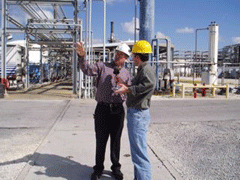
Jeff Young gets the tour of Tampa Electric's Polk Power Station from Plant Manager Mark Hornick.(Courtesy of Jeff Young)
HORNICK: We actually turn that solid fuel into a gaseous fuel before we use it in combustion turbines. And that’s what the gasification is all about.
YOUNG: The IGCC plant is a totally different animal from the old pulverized coal burner at Mount Storm. There’s no plume from a smokestack, no boiler with a glowing fireball. Gasification begins when a coal slurry is injected with oxygen into a high-pressure environment to create a gas. A turbine burns it to make power. But before that, pollutants like sulfur and particulates are stripped from the pressurized gas, and that’s much easier than dealing with the exhaust from a boiler. Hornick says that same method could be used to strip out CO2 as well.
HORNICK: Well it wouldn’t be small deal. But it’s certainly something that’s doable and proven in IGCC. If you’re gonna do CO2 removal from any plant it is gonna increase cost. For IGCC they estimate about a 25% increase, which is not insignificant. However if you look at conventional coal it would be over 50% and technology is a lot less proven.
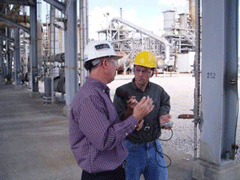
(Courtesy of Jeff Young)
IGCC plant to do it in three or four years—that’s remarkably fast in the world of power plants. And once captured the CO2 has to go somewhere. In some places it’s used to force oil and gas from old wells. It can also be pumped deep into formations in the earth where high pressure makes it a liquid. Small scale tests show the liquid CO2 stays underground.
A new study by MIT called “The Future of Coal” found most parts of the country could store large amounts of CO2. MIT chemistry professor John Deutch praises IGCC as a clean option for coal power but does not declare it the technological winner. Deutch served in both the US Department of Energy and CIA. He advocates much more research and development for all kinds of carbon capture and sequestration. He says current government spending doesn’t come close.
DEUTCH: We think that’s an urgent, urgent program for the Department of Energy to undertake, in this country, and for other countries to undertake around the world.

(Photo: Phillip J. Redman, U.S. Geological Survey)
MARKEY: You know, Saint Augustine used to say, “Oh lord make me chaste but not just yet.” These utility executives are saying, “Oh lord make me carbon free but not just yet.”
YOUNG: Markey leads a new special congressional committee on global warming and he’s pushing for a law to regulate greenhouse gas emissions. Without that, he says, it’s doubtful companies would pay to take the carbon out of coal.
For Living on Earth I’m Jeff Young in Washington D.C.
Related links:
- To view MIT’s study “The Future of Coal," click here
- Tampa Electric’s IGCC power plant
- Princeton’s Carbon Mitigation Initiative
[MUSIC: Donald Fagan “The Goodbye Look” From The Nightfly (Warner Bros. 1982)
Dioxane on the Defensive

Leila Love enjoys a nighttime bath. (Photo: Victoria Love)
CURWOOD: Bath time is one of the nicest rituals in caring for an infant. But it now turns out it could have a toxic dark side. A recent study has found that some of the most popular baby shampoos contain an industrial solvent that is suspected of causing cancer in humans, along with damaging the liver, kidneys, and nervous system. It’s called 1,4 Dioxane, and it is used to make shampoos and body washes, soft and bubbly. Now in the wake of the study some brands of shampoos containing the chemical are being pulled from the market. Living on Earth’s Ashley Ahearn has our report.
LOVE: Nice warm water wooooohh! There you go.
AHEARN: It’s bath time in the Love-Diggory household in Boston, MA and two-year-old Leila is getting her hair rinsed.
LOVE: Leila, can you put this over your eyes?
LEILA: No

Leila Love-Diggory enjoys a nighttime bath. (Photo: Victoria Love)
AHEARN: Victoria Love is trying to get Leila to put a washcloth over her big brown eyes to keep out the shampoo.
And while she can protect Leila’s eyes from the suds, she can’t protect her daughter from potentially dangerous substances that might be in her shampoo and other baby care products.
One substance in particular Love worries about is 1,4 Dioxane and with good reason. A recent study has found trace amounts of Dioxane in a number of widely-used baby care products, including Johnson and Johnson’s Kid Shampoo Watermelon Explosion, and Hello Kitty bubble bath.
DAVIS: I was frankly shocked to learn that widely used baby shampoos and soaps could contain a carcinogen.
AHEARN: That’s Dr. Devra Davis. She’s the head of the Environmental Oncology Center at the University of Pittsburgh and a professor of epidemiology at their Graduate School of Public Health.
Dioxane forms in these products as a result of a chemical reaction between other ingredients. One of them is Sodium Laurel Sulphate, an ingredient you’ve probably seen on the label of your shampoo or body wash.
It’s a normal detergent used in many soaps. Problem is, Dr. Davis says it’s a little harsh on tender skin.
She gives a little chemistry lesson:
DAVIS: What happens is that ethylene-oxide is added to the Sodium Laurel Sulphate to create Sodium Laureth Sulfate and in the process you get Di-Ethylene Oxide, which is another name for 1,4 Dioxane. It can be completely removed by what’s called vacuum stripping. This is something that is completely avoidable.
AHEARN: And Dr. Davis says elsewhere, it’s completely avoided.
DAVIS: 1,4 Dioxane, has been banned from cosmetics in Europe and the World Health Organization and the U.S. National Toxicology Program consider it to be a probable human carcinogen, because it causes cancer in male and female mice and rats.
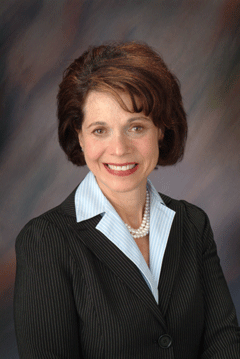
Dr. Devra Davis (Courtesy of the University of Pittsburgh)
In order for the F.D.A. to ban Dioxane from cosmetics, there would have to be demonstrated human harm.
Manufacturers complete internal testing for safety before putting products on the market, but the F.D.A. doesn’t do pre-market testing.
The F.D.A. press office declined requests for an interview with Living on Earth.
However, an Industry spokesman said he believes there’s no cause for alarm.
Dr. John Bailey is the executive vice president of science at the Cosmetic, Toiletry and Fragrance Association.
BAILEY: Virtually everything we’re surrounded by carries a hazard of some sort. I think that at the end of the day the levels of Dioxane in these products do not present a risk by any scientific measure.
[SPLASHING]
LOVE: Time to get out!
AHEARN: But when it comes to bathtime, Victoria Love would like to judge the safety of the products herself. At the very least she says she’d like ingredients such as 1,4 Dioxane to be listed on the bottle.
LOVE: But I really can’t believe that as a parent I’m in a position to you know, suddenly become a chemist in my free time to investigate, you know, every little product and you know, how it might have some adverse health effect and I’m hoping that the more people understand and realize, you know, what they’re actually being sold, people will start demanding change.
AHEARN: Some change is already in the works. Hello Kitty Bubble Bath had the highest Dioxane levels of the children’s bath products the study tested. And when contacted for this report, the distributor said they would initiate a recall process.
For Living on Earth, I’m Ashley Ahearn.
Related links:
- FDA Cosmetic Regulatory Page
- EU Risk Assessment of Dioxane
- To find out what’s in the products you use every day go to
- To view the lab results from the independent study on dioxane, click here
CURWOOD: Coming up: we introduce - The Wiggles composting worms, that is.
Stay tuned to Living on Earth.
[MUSIC: Christian Scott “Litany Against Fear” From Anthem (Concord Records 2007)]
A Movement Leader Speaks
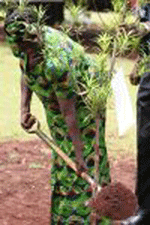
"Wangari Maathai planting a tree at the Outspan Hotel, Nyeri, Kenya, to mark the launch of her autobiography, Unbowed."(Photo: Wanjira Mathai)
CURWOOD: You're listening to an encore edition of Living on Earth. I'm Steve Curwood. Environmental and human rights activist, Wangari Maathai has written a memoir recounting her rise from life as a village girl in the countryside of Kenya to a celebrated green leader and winner of the Nobel Peace Prize. The book is called "Unbowed." Last week we spoke with her about her education and her early activism.
We continue the conversation this week beginning with a tale she tells in her book about a fig tree near her childhood home.
MAATHAI: Well, the story of the fig tree is a very interesting story because when I was growing up I was, like all of the other girl children of my age. I would collect firewood. I would fetch water from a nearby stream. And I remember that my mother told me not to collect the firewood from the fig tree. And I asked her why? And she said, “because that tree is the tree of God. We don’t burn it. We don’t cut it. We don’t use it for building. We let them stand for as long as they are able to.”

Wangari Maathai planting
a tree at the Outspan Hotel,
Nyeri,Kenya, to mark the
launch of her autobiography,
Unbowed. (Photo: Wanjira
Mathai)
And I didn’t think about it until much much later when I became, ah, more conscious about the role of trees in the environment. And then I appreciated the wisdom of our people in not cutting some of these trees, treating them as if they were sacred. And it was much later that I realized that these trees were very important for the stabilization of the land. Stabilizing the soil, making sure that you don’t have landslides and also making sure that a lot of the water that is in the ground is brought up from the underground from the belly of the earth along the roots of these trees. So they were very very important in the ecological system.
CURWOOD: Now when you went back as an adult in your later years what had happened to that tree?
MAATHAI: Unfortunately, when we introduced cash crops-coffee, tea, sugar canes- the tree was considered useless. It was no longer a holy tree because people were now Christians. And so it was cut to make way for tea bushes. Fortunately nothing has ever grown in the particular site where that tree was. It is as if only a fig tree was supposed to grow there.
CURWOOD: And what happened to the water? The…you said that the roots of the fig tree would bring up water. What happened to the water that was there?
MAATHAI: Very close to the fig tree there was this little stream. And I mention in the book that I used to play, ah, with frog eggs and with tadpoles in this steam. And this is the stream from which I would fetch water for my mother. But when this tree was cut the stream also dried up. We often take these trees, we often take the ecosystem for granted. Partly because we don’t understand how they are linked with each other and how together they create a harmony that makes life possible.
CURWOOD: I’d like to talk to you directly about your memoir for a moment which came out not so long ago. And it is fittingly called....
MAATHAI: Unbowed.
CURWOOD: And can you tell me about the title?
MAATHAI: We were trying to reflect the fact that even though we have gone through such a difficult life and we have gone through so many trials and tribulations we continue to walk tall and proud, unbowed.
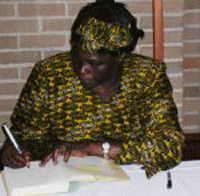
Wangari Maathai signs books at College of the Holy Cross in Worcester, Massachusetts. (Photo: Mia McDonald)
MAATHAI: Well, that is the tragedy of any people who are colonized. Those who colonized came to convince people that they are backwards, that they don’t have anything worth saving, that they need to emulate the lifestyle and the faith of those who have colonized them. And because those who colonized were often, you know, they had advanced technology, they came by ship, by horses, by trains. And so the natives were completely overwhelmed by the technology and the knowledge that the newcomers seemed to have. And so in that process the colonizers as I say, had perfected a system that was extremely powerful. And especially religion because when you tell people about a god, a god you never see, a god you can never ask questions. You can never go to God and say, “God, are these people telling me the truth or are they manipulating me so that I am vulnerable.” You can’t ask God those questions so it’s a very very powerful way of controlling people so that you can access and exploit their resources.
CURWOOD: At one point you write, that they uh and I’m quoting here that, “the trauma of the colonized are rarely examined. Steps are rarely taken to understand and redress it. The psychological damage passes from one generation to the next until victims recognize their dilemma and work to liberate themselves from the trauma.” How do you see that psychological damage from the years of colonization under the British, still present today?
MAATHAI: Well it is everywhere. You see it everywhere. You see it in the way people are disempowered, in the way that people don’t believe in themselves, in the way that people believe that they are less than those who colonized them. And it is made worse by the fact that those who became the new rulers who are natives , even they have that indoctrination. They literally continued to govern in the same way that the masters were governing. And that has been part of the problem of Africa.
We need to decolonize the minds of people who have been colonized. Until you decolonize those minds it’s very very difficult for the colonized to liberate themselves from the burden of self-doubt, the burden of self, um... sometimes-even self-hatred that they have. And the tragedy is they don’t know that, that’s what happened to them. Because quite often what has happened to them is projected as progress. It is projected as development.
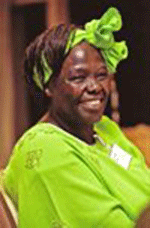
Wangari Maathai in Japan,
February 2005. (Photo:
Mainichi Corporation)
CURWOOD: I know one area where you’ve been raising awareness, ah, is the importance of the vast tropical rainforest in Africa’s Congo Basin, which is so much less known than the Amazon rainforest. How’s that going?
MAATHAI: That’s going well. And I’m very very happy that the climate change discussion is gaining momentum. And people are recognizing that one of the ways in which we can help the planet is by planting trees but also by protecting the trees that are standing. So I hope that governments that have money will help the African governments so that they can protect that forest from logging. Because it’s also important to say that the logging is not being done by local people. The logging of these forests is usually done by big timber companies from developed countries.
So considering that it is the developed countries that have contributed so much to the green house gasses that are causing the warming up of the earth it is only appropriate that they too should participate in assisting governments, not only to stop the logging , but to help with the rehabilitation of the logged areas.
CURWOOD: I want to mention something personal to you. I live in New Hampshire and it’s an old old house, 250 years old, and there’s a sugar maple, there’s a bunch of sugar maples, that were planted probably not long after the house was built and one of them has run out of time. It’s probably 175 years old. The wires that have been holding it together and the other efforts that have been made to keep it going- just nothing more can be done. And it has to come down; in fact I think it’s going to come down tomorrow.
MAATHAI: I’m so sorry to hear that. But it also means that we understand that all living things come to an end. And the only thing we can say is that is after so many years of service that tree is ready to be recycled. How wonderful it would be if all of us would be recycled when our time comes and we would be able to say, like that tree, “I have done my part.”
CURWOOD: Professor Maathai thank you so much for being with us today.
MAATHAI: Thank you.
CURWOOD: And I want to give you the opportunity to say anything else that you’d like to say.
MAATHAI: Well I would just like to remind our listeners that recently in Nairobi we launched a billion tree campaign. We are appealing to all the people in the world, throughout the world where ever you are, who ever you are if you can plant a tree... there are six billion of us. If at least one out of six planted a tree we would very easily reach our target. It is not as if we will solve all the crises of the climate with those billion trees, but at least it’s one way of doing something to contribute towards solving the problem. Let us be part of the solution and not part of the problem.
CURWOOD: Wangari Maathai, winner of the 2004 Nobel Peace Prize, thank you so much.
MAATHAI: Thank you very much .
CURWOOD: Wangari Maathai is Kenya’s Deputy Minister of the Environment and founder of the Greenbelt Movement. Her new memoir is called “Unbowed.” You can hear the first part of our conversation with Wangari Maathai… as well as a one-hour documentary about her life at our website, l-o-e dot o-r-g. You can also find information there about her campaign to plant one billion trees. The only thing is, you have to help.
Related links:
- The Green Belt Movement
- Green Belt Movement blog
- Wangari Maathai's "Unbowed"
- UNEP's "Plant for the Planet: Billion Tree Campaign"
[MUSIC: Gabriel Omolo “Lunch Time” from Kenya Dance Party (Earthworks 1991)]
A Wriggly Business
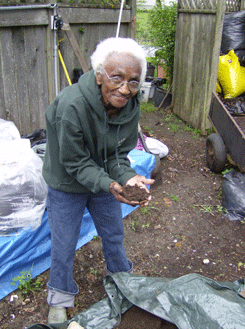
Maggie shows off the worm beds of The Cape Cod Worm Farm. She's been raising and selling worms from her home in Buzzards Bay, MA since 1974. (Photo: Ian Gray)
CURWOOD: Some people have an unusual ability to improvise. Necessity seems to only make them more creative. Today we bring you the story of one such woman. Maggie Pipkins is 87. Although her husband served in the Air Force, money was always tight so Mrs. Pipkins, who prefers to be called "Maggie," started a business - a worm farm. These days, she ships out these natural earth tillers--garden worms-- and their castings by the ton. They go to customers in Europe, Africa, and other parts of the world.
From Cape Cod, Massachusetts, producer Ian Gray has this profile.
[HOEING]
GRAY: That’s the sound of Maggie Pipkins, turning over piles of rotting apples with a hoe.
[FARM WIND SOUNDS]
PIPKINS: That’s where the money comes from. I grew up in Louisiana, and I’d had a lot of experience with farm work.
[MUSIC: Bela Fleck “Arkansas Traveler” from ‘Tales from the Acoustic Planet’ (Warner Bros. - 1995)]
PIPKINS: The farm belonged to my parents, and they grew a lot of cotton. And my dad grew everything: turnips, mustards, cabbage, watermelon cantaloupes, beets, you name it and he grew it.
[MUSIC: Bela Fleck “Cheeseballs in Cowtown” from ‘Tales from the Acoustic Planet’ (Warner Bros. – 1995)]

Maggie shows off the worm beds of The Cape Cod Worm Farm. She's been raising and selling worms from her home in Buzzards Bay, MA since 1974. (Photo: Ian Gray)
[MUSIC: Bela Fleck “Cheeseballs in Cowtown” from ‘Tales from the Acoustic Planet’ (Warner Bros. – 1995)]
PIPKINS: My husband’s income wasn’t enough to put the children through the type of school that I wanted them to be educated from. So, I read this article in the newspaper about the people selling worms to people who would raise them and they would buy them back. But I didn’t go for that because I’d had a lot of experience with that kind of work.
GRAY: To Maggie, raising worms for somebody else seemed too much like raising cotton for somebody else.
PIPKINS: So I decided to try on my own.
[MUSIC: Bela Fleck “Cheeseballs in Cowtown” from ‘Tales from the Acoustic Planet’ (Warner Bros. – 1995)]
GRAY: She began her business, The Cape Cod Worm Farm, with a handful of leftovers.
PIPKINS: My husband at the time was at Otis, and they do a lot of fishing, the Southern guys that was out there, so he joined the gang. So he had to have earthworms. He bought some.
[MUSIC: Bela Fleck “Cheeseballs in Cowtown” from ‘Tales from the Acoustic Planet’ (Warner Bros. – 1995)]
PIPKINS: When it was over I took those that were left and began to experiment. And it was a very few worms in there, but it doesn’t take a lot of worms. You put maybe a half a dozen worms together in a container and they do their thing. You know they eat, they mate, they lay eggs and they hatch, and before you know it you have a lot of worms.
[MUSIC: Bela Fleck “Cheeseballs in Cowtown” from ‘Tales from the Acoustic Planet’ (Warner Bros. – 1995)]
PIPKINS: I tried newspaper, cardboards, coffee grinds, banana peelings, eggshells. All of those things. Not in one container, but in different containers as I went along.
[STORAGE ROOM SOUNDS]
PIPKINS: This is a storage, but this is where…go right on in…should be a light here…if I can find the light, thank you…and I had worms everywhere, I had my bathtub was in here, there’s a lot of junk in there now, but I had a bathtub, a coffee pot, and all kind of containers and buckets, and my boat was right across here, a big boat was right across there.
GRAY: A ten-foot dinghy, full of worms. At one point I made the mistake of referring to the soil the worms were in as dirt.
PIPKINS: No, there’s no dirt, no dirt because they’re eating it and making fertilizer out of it. The soil is three things that you mix together, peat moss…okay…leaf mold, cow manure or horse manure. And they eat that over and over and over along with other food that you put in there. I sell more than three tons of casting at a time.
GRAY: How long does it take to make three tons?
PIPKINS: You leave the worms in it 3 months at the most, and it depends how many worms you have. They’re just eating it and it’s going through them and they’re eating it over and over again.
[MUSIC: Bela Fleck “Cheeseballs in Cowtown” from ‘Tales from the Acoustic Planet’ (Warner Bros. – 1995)]
PIPKINS: Life has been very good to me. And all of my kids went to college. Yeah!
GRAY: And you sent your husband to college too?
PIPKINS: Yes, he went. And if I wasn’t working then he wouldn’t been able because he would have had to spend more time trying to keep us going.
Being self-employed really help you to be free and to take care of the things you need to take care of the things that you need with your family. So either you are there to help them do what they have to do and give them support, or you’re away working for somebody else. And I don’t know anybody that I would rather work for than to work for Maggie…I really like working for her!
CURWOOD: Our profile of Maggie Pipkins was produced by Ian Gray. To learn more about Maggie and her worm business, visit a website designed by her great-granddaughter, Rotiche. You can get there by way of the Living on Earth website: Living on Earth dot org.
Related link:
Cape Cod Worm Farm
[Bela Fleck “Arkansas Traveler” and “Cheeseballs In Cowtown” from Tales Of The Acoustic Planet (Warner Bros 1995)]
CURWOOD: Just ahead: a country music star returns to her coal country roots. Keep listening to Living on Earth.
ANNOUNCER: Funding for Living on Earth comes from the National Science Foundation, supporting coverage of emerging science; And Stonyfield Farm: Organic yogurt, smoothies and milk. Ten percent of profits are donated to efforts that help protect and restore the earth. Details at Stonyfield dot com. Support also comes from you our listeners, the Ford Foundation, the Oak Foundation, and the Saunders Hotel Group of Boston's Lennox and Copley Square Hotels. Serving you and the environment while helping preserve the past and protect the future, 800-225-7676.
Coal Country Crooner

Kathy Mattea (Photo: Kristen Barlowe)
CURWOOD: This is Living on Earth. I’m Steve Curwood. Coal runs thick in the blood of many if not most West Virginians. Kathy Mattea is one of them. She grew up in West Virginia coal country before heading off to Nashville and a long and successful career as a country singer. Her recordings have been number one on the Billboard Country Music charts time after time. And it’s hard to turn on a country radio station without hearing such hits as “Love at the Five and Dime” and “Eighteen Wheels and a Dozen Roses.”
[MUSIC: Kathy Mattea “18 Wheels And A Dozen Roses” from Untasted Honey (UMG Records 1987)]
Now in her most recent work, Kathy Mattea is turning her attention back to her roots- acoustic music and coal country. Her latest recording project explores the heritage of her home state and of her own family in coal mining. Kathy Mattea and her guitar join us from Nashville. Welcome to Living on Earth.
MATTEA: How you doing?
CURWOOD: Now, you’ve recorded a number of songs that explored the heritage of coal mining. What was your family’s relation to coal mining, your dad’s relationship?
MATTEA: Well, both my grandfathers were coal miners. My dad was the only son. There were six kids in his family and he was the only boy. And uh because my uncle gave him the money to go to school, go to college, he didn’t have to go into the mines. But that was sort of everybody’s, you know, everybody in his town that was sort of what you did. And ah, my mom grew up in a family with six sisters and my grandfather on her side was a coal miner as well. And you know just lots of family stories, lots of family lore and uncles who were in the mines.
CURWOOD: Now in addition to the effects of mining coal and living with coal itself I understand that you’ve also been thinking a lot about the effects of burning coal, specifically its contribution to global warming. Can you tell me about that?
MATTEA: Yeah, it’s been an interesting journey this last year. In January of 2006 I went to see former Vice President Gore give his power point presentation over at Vanderbilt University and ah I didn’t sleep for two nights after that. I mean, I was just haunted by what I had seen and the evidence just seemed so compelling and so overwhelming and I learned to give the slideshow and have been giving it in various settings over the last few months. And ah, it’s interesting, I began to sleep again once I really started taking action. That was the thing I learned along the way was that I feel helpless until I begin to be a part of the solution. And we are each a very important part of this solution.
CURWOOD: Half of the electricity in this country does come from coal, thereabouts, so maybe there’s a 50-50 chance it came from coal, but since you’re in Nashville and I’m in Somerville, Massachusetts probably one of these studios was fired by coal.
MATTEA: Yeah, it’s something that people don’t think about. And here’s the other part of it: the big seams of coal in West Virginia and Kentucky have all been mined. So what’s left are real thin seams and that means strip mining. Strip mining is rampant right now and it’s raping, it’s raping the countryside. What if you knew that every time you flip on your light switch a mountaintop in West Virginia just blows up? It’s crazy. In these rural areas a lot of times that is the best way to make money if you are unskilled labor, if you don’t have a college degree. And so you know, you don’t have a lot of power if you want to stay on the piece of land where your family has been for generations. There’s just a lot to it.
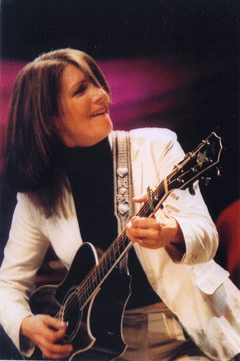
Kathy Mattea live (Courtesy of Mattea.com)
MATTEA: I think the first one was Coal Tattoo, which is a Bill Ed Wheeler song. It’s been around for a long time.
[MUSIC: Kathy Mattea “Coal Tattoo” from ‘Coal’ (Label TBA - 2007)]
MATTEA: Dark as a Dungeon was on the list. And then I just started researching and found some old songs from the sixties and the fifties and found some modern songs and just tried to kind of find a nice mix. My goal was to be able to tell this story and to maybe open up a window into it that people who have not heard these songs before, hopefully they might find some accessibility there.
CURWOOD: What about the story of Lawrence Jones?
MATTEA: Ah. Well, there was a strike in the early seventies in Harlan County and it was horrible. It wound up going on for 13 months. And these people were fired on with machine guns. They were called out of their houses and killed. The whole thing kind of came to a head when one of the, they call them “gun thugs,” one of the people hired by the company to intimidate the strikers, shot a young miner in the face with a shot gun. And he went into the hospital and eventually died after a few days. He had a 16-year-old wife and a new-born baby at the time. And it was sort of the last straw. The miners had been fighting a long time and that was the last straw that got the contract agreed to between the UNW and the company. And this tribute to him which was written by Sy Con is just the most beautiful and reverent and empowering song about people without a lot of options. Just refusing to back down in the face of what they know to be right.
CURWOOD: Would you play it for us now?
MATTEA: I’d be happy to.
CURWOOD: Thank you.
[MUSIC: Kathy Mattea “Lawrence Jones” from ‘Spotland Productions Live In-Studio Performance’ (Nashville, TN – April 2007)]
CURWOOD: Thank you so much. Now you’ve chosen for your coal project a number of songs that well, they just clearly admire people who mine coal who give their lives and their fortunes to mine coal and endure all the hardships that come along with it. But if the United States were to take concerted action on climate change wouldn’t that be kind of hard on the coal mining regions of the country like West Virginia?
MATTEA: Well, I think that’s part of what we have to talk about. We have to try to get into a solution so that we can make some kind of sensible solution to cleaner power. I think there are going to be many facets to the solution. There are people doing research right now on how to burn coal cleaner. So it may not be that we have to eliminate coal, but you know if our appetite for energy is so big right now, that we will blow up mountain tops to the point where we have strip mines in West Virginia as big as half the area of Manhattan. You know these things, it’s not just the beauty of the mountain that’s lost. The Appalachian forest is the most diverse forest in North America. So we’re losing habitat. We’re losing species. The sludge ponds are contaminating the water and then when they blast off the mountain tops and push all of that dirt that is not coal into the valleys it contaminates the water for the people who live in the area. People in West Virginia are screaming about this and people who mine the coal are screaming about this. It is a complex problem. But if we can’t discuss it because we are so married to the way things are, then we can’t find our way to a solution and we must.

Kathy Mattea (Photo: Kristen Barlowe)
MATTEA: Yes.
CURWOOD: You have a song about a bird that you’re lucky to see down there.
MATTEA: (laughs) Yeah, this a, God this is just a wonderful song and it so much speaks to the kind of risk that these miners take every day so we’ll have electricity. You know how much danger these guys work in everyday. And it’s just an eloquent piece written by Billy Ed Wheeler.
MUSIC: Kathy Mattea “Blackbird” from ‘Spotland Productions Live In-Studio Performance’ (Nashville, TN – April 2007)
CURWOOD: Phew…whoa, boy you dig deep into that tune.
MATTEA: Oh man, that tune is so amazing, just an amazing piece of writing.
CURWOOD: As you’ve reflected on doing this coal project on the one hand you see coal giving people jobs and fueling the country. On the other hand of course it’s taken quite a toll on people and your home state of West Virginia. So tell me, is coal a gift or a curse for West Virginia?
MATTEA: Yeah. I think it is and it’s reflected in so many of these songs as well. There is a love-hate relationship all the way across the board. Almost from any angle you slice it. And as I’ve made this project I have a piece of coal sitting on my desk. I just keep kind of looking at it. It’s bituminous coal, it’s all shinny. And ah you know, I thought that’s really good to be able to just reach out and touch it every once in a while. I know what it smells like when it burns. I know how hot it burns. I know what it’s like to go to the railroad track and gather it up. And I feel like this is part of my history and I have kind of a unique position you know: kind of one foot in the modern world and one foot in a kind of older history. And it’s very scary to bring that up in the face of global warming but we have to be able to talk about these things. We have to.
CURWOOD: Kathy Mattea’s next album is called “Coal.” Thank you so much for taking this time.
MATTEA: Thank you for having me. It’s been a pleasure.
Related links:
- Kathy Mattea's Coal Project website
- Kathy Mattea's official website
[MUSIC: Kathy Mattea “Acoustic Guitar Instrumental” from ‘Spotland Productions Live In-Studio Performance’ (Nashville, TN – April 2007)]
CURWOOD: Next week on Living on Earth: Insomnia, back pains, nausea, headaches: some folks treat these and other ailments with herbal remedies. One Mexican teenager from Los Angeles strives to carry on his family tradition of healing.
JAUREGUI: I've been gathering plant samples and taping them into my notebook, writing all I know about each one. Most of what I know of medicinal plants comes from seeing my mom use them.
CURWOOD: Traditional healing for the next generation next time on Living on Earth.
CURWOOD: We leave you this week – in a riverine marsh in Florida.
[BIRD CALLS]
Lang Elliot and Ted Mack went to the Wacissa River’s edge and recorded chattering Grebes, a Limpkin, and the harsh call of a Red-shouldered Hawk.
CURWOOD: Living on Earth is produced by the World Media Foundation. Our crew includes Ashley Ahearn, Eileen Bolinsky, Bruce Gellerman, Ian Gray, Ingrid Lobet, and Jeff Young - with help from Bobby Bascomb, and Kelley Cronin.
Jeff Turton is our technical director. Alison Lirish Dean composed our themes. You can find us anytime at LOE dot org. I’m Steve Curwood.
From all of us here at Living on Earth, thanks for listening.
ANNOUNCER: Funding for Living on Earth comes from the National Science Foundation, supporting coverage of emerging science; And Stonyfield Farm: Organic yogurt, smoothies and milk. Stonyfield pays its farmers not to use artificial growth hormones on their cows. Details at Stonyfield dot com.
Support also comes from you our listeners, the Ford Foundation, the Wellborn Ecology Fund and Pax World Mutual Funds—socially and environmentally sustainable investing. Pax World, for tomorrow. On the Web at paxworld dot com.
ANNOUNCER: This is PRI. Public Radio International.
Living on Earth wants to hear from you!
Living on Earth
62 Calef Highway, Suite 212
Lee, NH 03861
Telephone: 617-287-4121
E-mail: comments@loe.org
Newsletter [Click here]
Donate to Living on Earth!
Living on Earth is an independent media program and relies entirely on contributions from listeners and institutions supporting public service. Please donate now to preserve an independent environmental voice.
NewsletterLiving on Earth offers a weekly delivery of the show's rundown to your mailbox. Sign up for our newsletter today!
 Sailors For The Sea: Be the change you want to sea.
Sailors For The Sea: Be the change you want to sea.
 The Grantham Foundation for the Protection of the Environment: Committed to protecting and improving the health of the global environment.
The Grantham Foundation for the Protection of the Environment: Committed to protecting and improving the health of the global environment.
 Contribute to Living on Earth and receive, as our gift to you, an archival print of one of Mark Seth Lender's extraordinary wildlife photographs. Follow the link to see Mark's current collection of photographs.
Contribute to Living on Earth and receive, as our gift to you, an archival print of one of Mark Seth Lender's extraordinary wildlife photographs. Follow the link to see Mark's current collection of photographs.
 Buy a signed copy of Mark Seth Lender's book Smeagull the Seagull & support Living on Earth
Buy a signed copy of Mark Seth Lender's book Smeagull the Seagull & support Living on Earth

